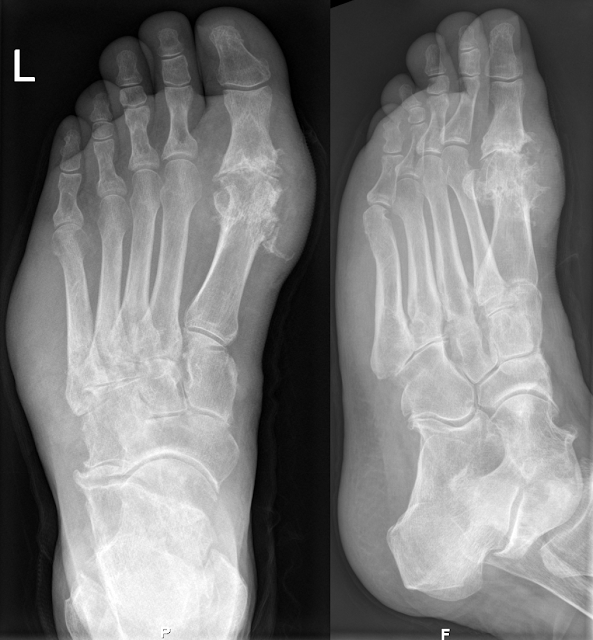The bone structure of our foot is complex because of the collection of tendons, soft tissues, muscles, and bones. When it comes to toe fractures, the most common bones, which suffer injuries are the phalanges—the bones in the toes, and the metatarsal bones. These are the slender bones that are found on the mid-foot area.
Toe Fracture Types
There are two main types of toe fractures. These two categories have other sub-types falling into them:
• Traumatic fractures- also known as acute fractures. This type of injury is often the result of a direct blow or by a hard impact. Common examples of situations wherein traumatic fractures happen are sports accidents or toe stubbing incidents. Traumatic toe fractures can either be non-displaced or displaced. Displaced fractures are cases when the broken bone has been dislocated.
• Stress fracture toe: These are hairline cracks on the bones that are caused by repetitive stress. This type of injury is common among runners and athletes who excessively train themselves and continually push their bodies to the limit. Stress fractures can also be the cause of abnormal structure of the bones of the feet or even caused by osteoporosis. People who also often wear uncomfortable footwear can develop this injury. Even though stress fractures are considered way milder than traumatic fractures, they should not be ignored because they can develop into deformities and worse injuries when left untreated.
Diagnosis
For toe stress fractures, the doctor will need to ask for an x-ray or CT scan to see the extent of the injury. The injured foot will be examined to identify the main area that is tender and swollen. For mild cases, doctors may only ask for an x-ray. However, bone scans are required for patients with suspected stress fractures because the hairline scans cannot be detected by regular x-rays alone.
Causes
• Accidents. These can happen during biking or running.
• Use of improper shoes and wearing small-sized footwear can also cause toe fractures.
• Sports or training. Over practicing and engaging in sport activities, which require extreme use of footwork.
Symptoms
Symptoms are based from the type of toe fractures suffered.
For traumatic fractures:
• Cracking sound during the time the force is received
• Extreme pain after receiving the impact. Pain can also be felt few hours after the accident.
• Deformed appearance of toes.
• Swelling or bruises 24 hours after the accident
For stress fracture toe:
• Pain while doing normal activities such as walking or tip-toeing
• Pain that is only felt while doing activities that require standing up but goes away when resting or sitting down
• Pain at the site injured when touched
• Swelling of the area
Fractured Toe Treatment
The type of treatment is dependent on the kind of injury of the patient. Toe fractures, for example, are always considered as traumatic fractures and may need specific care. Mild fractures may only need a few weeks of rest. In more severe cases, however, treatment may need the use special tools like splinters, stiff-soled shoes, buddy taping, or surgeries. Finger supports are also used so that the broken toe can heal back into its original density. Stiff-soled shoes, on the other hand, are prescribed to be used when the patients need to go out. Stiff-soled footwear are just like removable cast because it keep the broken toe in its proper position, protecting it from further damage and at the same time allowing the patient to move.
Moreover, buddy-taping is a method which involves putting a bandage on the damaged toe and the undamaged one next to it. Both of these will be taped together for support and to prevent unnecessary movements that can further the injury. Surgery is considered as the last option for traumatic fractures and will only be required if the toe has been severely displaced and affecting its neighboring joints.
For stress toe fractures, resting is considered as the number one treatment because the bones need time to heal. Avoiding the activity which caused the injury is necessary. Sometimes, temporary use of crutches or wheelchair is also prescribed to minimize the force that is placed on the damaged toe. Patients who are suffering from stress fractures are also recommended to have follow-up care such as doing regular exercises, physical therapy, and rehabilitation.
Prevention
To prevent toe fractures, patients especially those who had stress fracture on big toe, are advised to take it easy when engaged in rigorous activities. Athletes who cannot avoid training should do their workouts in a slow and gradual manner so that the bones in the foot would not get overworked.
When to Call a Doctor
Mild fractures may need around 6 weeks to heal the fractured toe completely. Injuries which continue to hurt should be immediately reported to the doctor. Also, do not assume that your toe is already strong enough to absorb the shock when it has recovered. A recovered fractured toe will always be vulnerable to fracture if it is subjected again to the same stress. If ever you feel pain on the recovered toe, consult with your physician about it.

Comments
Post a Comment
Please do not enter any spam link in the comment box.